数据结构 栈和队列的基本操作实现及其应用
- 格式:doc
- 大小:64.00 KB
- 文档页数:8
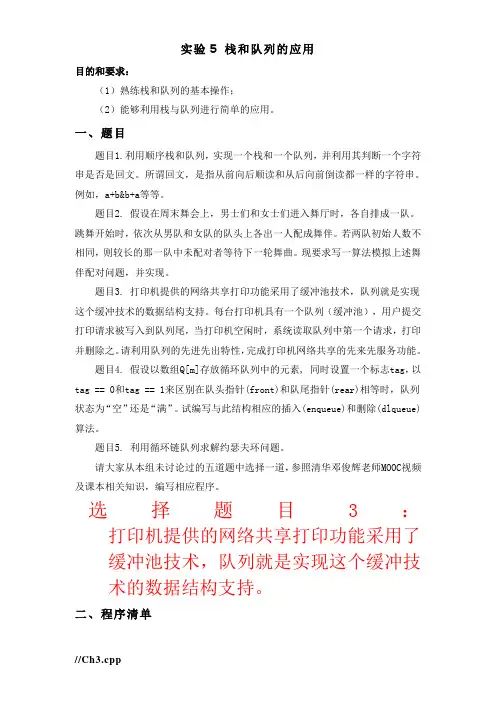
实验5 栈和队列的应用目的和要求:(1)熟练栈和队列的基本操作;(2)能够利用栈与队列进行简单的应用。
一、题目题目1.利用顺序栈和队列,实现一个栈和一个队列,并利用其判断一个字符串是否是回文。
所谓回文,是指从前向后顺读和从后向前倒读都一样的字符串。
例如,a+b&b+a等等。
题目2. 假设在周末舞会上,男士们和女士们进入舞厅时,各自排成一队。
跳舞开始时,依次从男队和女队的队头上各出一人配成舞伴。
若两队初始人数不相同,则较长的那一队中未配对者等待下一轮舞曲。
现要求写一算法模拟上述舞伴配对问题,并实现。
题目3. 打印机提供的网络共享打印功能采用了缓冲池技术,队列就是实现这个缓冲技术的数据结构支持。
每台打印机具有一个队列(缓冲池),用户提交打印请求被写入到队列尾,当打印机空闲时,系统读取队列中第一个请求,打印并删除之。
请利用队列的先进先出特性,完成打印机网络共享的先来先服务功能。
题目4. 假设以数组Q[m]存放循环队列中的元素, 同时设置一个标志tag,以tag == 0和tag == 1来区别在队头指针(front)和队尾指针(rear)相等时,队列状态为“空”还是“满”。
试编写与此结构相应的插入(enqueue)和删除(dlqueue)算法。
题目5. 利用循环链队列求解约瑟夫环问题。
请大家从本组未讨论过的五道题中选择一道,参照清华邓俊辉老师MOOC视频及课本相关知识,编写相应程序。
选择题目3:打印机提供的网络共享打印功能采用了缓冲池技术,队列就是实现这个缓冲技术的数据结构支持。
二、程序清单//Ch3.cpp#include<iostream.h>#include<stdio.h>#include"ch3.h"template <class T>void LinkedQueue<T>::makeEmpty()//makeEmpty//函数的实现{LinkNode<T>*p;while(front!=NULL)//逐个删除队列中的结点{p=front;front=front->link;delete p;}};template <class T>bool LinkedQueue<T>::put_in(T&x){//提交命令函数if(front==NULL){//判断是否为空front=rear=new LinkNode<T>;//如果为空,新结点为对头也为对尾front->data=rear->data=x;if(front==NULL) //分配结点失败return false;}else{rear->link=new LinkNode<T>;//如不为空,在链尾加新的结点rear->link->data=x;if(rear->link==NULL)return false;rear=rear->link;}return true;};template <class T>bool LinkedQueue<T>::carry_out()//执行命令函数{if(IsEmpty()==true)//判断是否为空{ return false; }cout<<front->data<<" ";//输出链尾的数据,代表执行打印命令LinkNode<T>*p=front;front=front->link;//删除以执行的命令,即对头修改delete p; //释放原结点return true;};void main() //主函数{LinkedQueue<char> q;//定义类对象char flag='Y'; //标志是否输入了命令const int max=30;//一次获取输入命令的最大个数while(flag=='Y') //循环{int i=0;char str[max]; //定义存储屏幕输入的命令的数组gets(str); //获取屏幕输入的命令while(str[i]!='\0'){q.put_in(str[i]);//调用提交命令函数,将每个命令存入队列中i++;}for(int j=0;j<=i;j++){if(q.IsEmpty()==true) //判断是否为空,为空则说明没有可执行的命令{cout<<"已经没有可执行的命令!是否继续输入命令(Y|N)?"<<endl;cin>>flag;continue; //为空跳出for循环为下次输入命令做好准备}q.carry_out();//调用执行命令的函数,将命令打印并删除}三、程序调试过程中所出现的错误无。
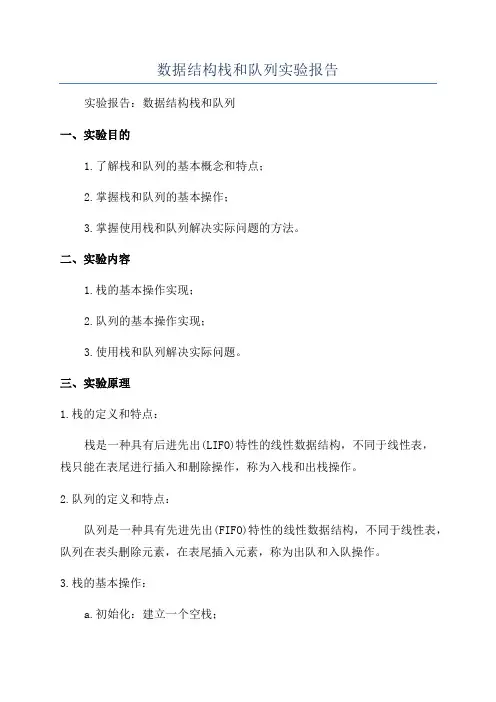
数据结构栈和队列实验报告实验报告:数据结构栈和队列一、实验目的1.了解栈和队列的基本概念和特点;2.掌握栈和队列的基本操作;3.掌握使用栈和队列解决实际问题的方法。
二、实验内容1.栈的基本操作实现;2.队列的基本操作实现;3.使用栈和队列解决实际问题。
三、实验原理1.栈的定义和特点:栈是一种具有后进先出(LIFO)特性的线性数据结构,不同于线性表,栈只能在表尾进行插入和删除操作,称为入栈和出栈操作。
2.队列的定义和特点:队列是一种具有先进先出(FIFO)特性的线性数据结构,不同于线性表,队列在表头删除元素,在表尾插入元素,称为出队和入队操作。
3.栈的基本操作:a.初始化:建立一个空栈;b.入栈:将元素插入栈的表尾;c.出栈:删除栈表尾的元素,并返回该元素;d.取栈顶元素:返回栈表尾的元素,不删除。
4.队列的基本操作:a.初始化:建立一个空队列;b.入队:将元素插入队列的表尾;c.出队:删除队列表头的元素,并返回该元素;d.取队头元素:返回队列表头的元素,不删除。
四、实验步骤1.栈的实现:a.使用数组定义栈,设置栈的大小和栈顶指针;b.实现栈的初始化、入栈、出栈和取栈顶元素等操作。
2.队列的实现:a.使用数组定义队列,设置队列的大小、队头和队尾指针;b.实现队列的初始化、入队、出队和取队头元素等操作。
3.使用栈解决实际问题:a.以括号匹配问题为例,判断一个表达式中的括号是否匹配;b.使用栈来实现括号匹配,遍历表达式中的每个字符,遇到左括号入栈,遇到右括号时将栈顶元素出栈,并判断左右括号是否匹配。
4.使用队列解决实际问题:a.以模拟银行排队问题为例,实现一个简单的银行排队系统;b.使用队列来模拟银行排队过程,顾客到达银行时入队,处理完业务后出队,每个顾客的业务处理时间可以随机确定。
五、实验结果与分析1.栈和队列的基本操作实现:a.栈和队列的初始化、入栈/队、出栈/队以及取栈顶/队头元素等操作均能正常运行;b.栈和队列的时间复杂度均为O(1),操作效率很高。
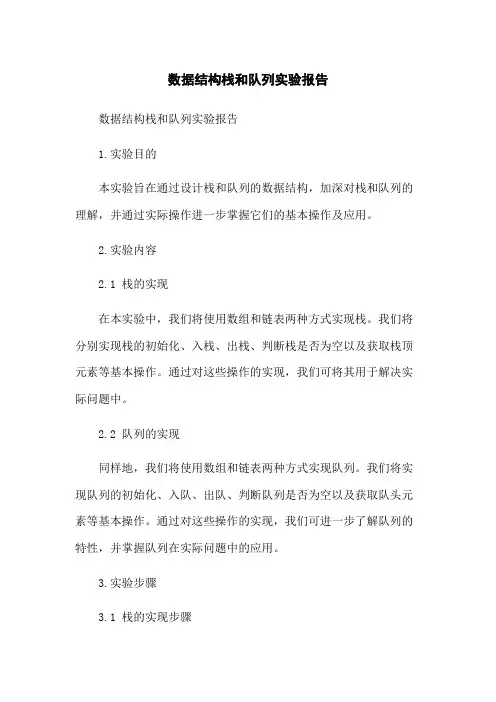
数据结构栈和队列实验报告数据结构栈和队列实验报告1.实验目的本实验旨在通过设计栈和队列的数据结构,加深对栈和队列的理解,并通过实际操作进一步掌握它们的基本操作及应用。
2.实验内容2.1 栈的实现在本实验中,我们将使用数组和链表两种方式实现栈。
我们将分别实现栈的初始化、入栈、出栈、判断栈是否为空以及获取栈顶元素等基本操作。
通过对这些操作的实现,我们可将其用于解决实际问题中。
2.2 队列的实现同样地,我们将使用数组和链表两种方式实现队列。
我们将实现队列的初始化、入队、出队、判断队列是否为空以及获取队头元素等基本操作。
通过对这些操作的实现,我们可进一步了解队列的特性,并掌握队列在实际问题中的应用。
3.实验步骤3.1 栈的实现步骤3.1.1 数组实现栈(详细介绍数组实现栈的具体步骤)3.1.2 链表实现栈(详细介绍链表实现栈的具体步骤)3.2 队列的实现步骤3.2.1 数组实现队列(详细介绍数组实现队列的具体步骤)3.2.2 链表实现队列(详细介绍链表实现队列的具体步骤)4.实验结果与分析4.1 栈实验结果分析(分析使用数组和链表实现栈的优缺点,以及实际应用场景)4.2 队列实验结果分析(分析使用数组和链表实现队列的优缺点,以及实际应用场景)5.实验总结通过本次实验,我们深入了解了栈和队列这两种基本的数据结构,并利用它们解决了一些实际问题。
我们通过对数组和链表两种方式的实现,进一步加深了对栈和队列的理解。
通过实验的操作过程,我们也学会了如何设计和实现基本的数据结构,这对我们在日后的学习和工作中都具有重要意义。
6.附件6.1 源代码(附上栈和队列的实现代码)6.2 实验报告相关数据(附上实验过程中所产生的数据)7.法律名词及注释7.1 栈栈指的是一种存储数据的线性数据结构,具有后进先出(LIFO)的特点。
栈的操作主要包括入栈和出栈。
7.2 队列队列指的是一种存储数据的线性数据结构,具有先进先出(FIFO)的特点。
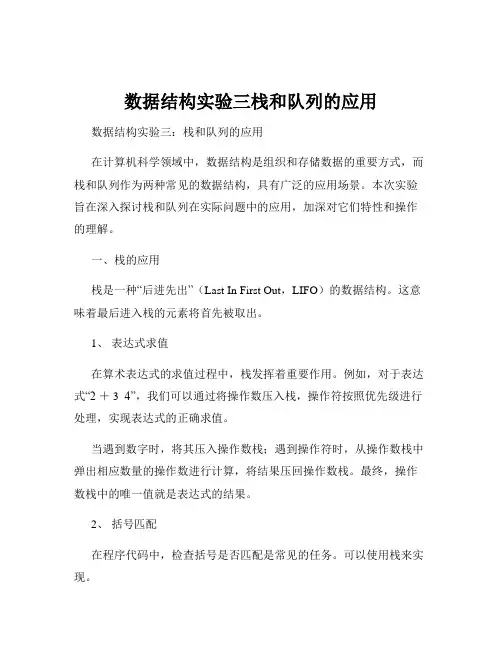
数据结构实验三栈和队列的应用数据结构实验三:栈和队列的应用在计算机科学领域中,数据结构是组织和存储数据的重要方式,而栈和队列作为两种常见的数据结构,具有广泛的应用场景。
本次实验旨在深入探讨栈和队列在实际问题中的应用,加深对它们特性和操作的理解。
一、栈的应用栈是一种“后进先出”(Last In First Out,LIFO)的数据结构。
这意味着最后进入栈的元素将首先被取出。
1、表达式求值在算术表达式的求值过程中,栈发挥着重要作用。
例如,对于表达式“2 + 3 4”,我们可以通过将操作数压入栈,操作符按照优先级进行处理,实现表达式的正确求值。
当遇到数字时,将其压入操作数栈;遇到操作符时,从操作数栈中弹出相应数量的操作数进行计算,将结果压回操作数栈。
最终,操作数栈中的唯一值就是表达式的结果。
2、括号匹配在程序代码中,检查括号是否匹配是常见的任务。
可以使用栈来实现。
遍历输入的字符串,当遇到左括号时,将其压入栈;当遇到右括号时,弹出栈顶元素,如果弹出的左括号与当前右括号类型匹配,则继续,否则表示括号不匹配。
3、函数调用和递归在程序执行过程中,函数的调用和递归都依赖于栈。
当调用一个函数时,当前的执行环境(包括局部变量、返回地址等)被压入栈中。
当函数返回时,从栈中弹出之前保存的环境,继续之前的执行。
递归函数的执行也是通过栈来实现的,每次递归调用都会在栈中保存当前的状态,直到递归结束,依次从栈中恢复状态。
二、队列的应用队列是一种“先进先出”(First In First Out,FIFO)的数据结构。
1、排队系统在现实生活中的各种排队场景,如银行排队、餐厅叫号等,可以用队列来模拟。
新到达的顾客加入队列尾部,服务完成的顾客从队列头部离开。
通过这种方式,保证了先来的顾客先得到服务,体现了公平性。
2、广度优先搜索在图的遍历算法中,广度优先搜索(BreadthFirst Search,BFS)常使用队列。
从起始节点开始,将其放入队列。
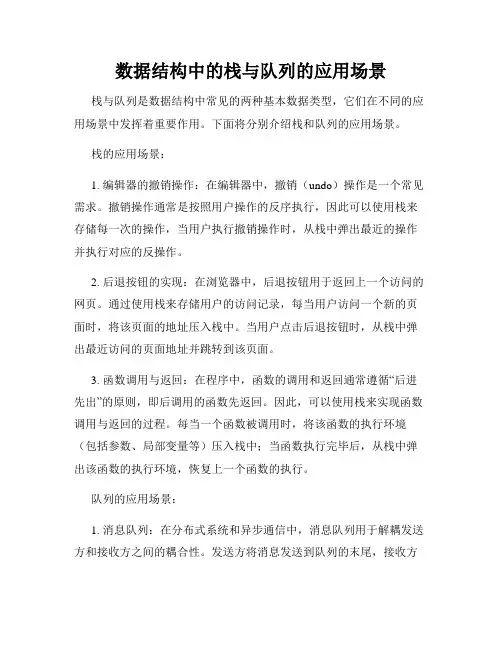
数据结构中的栈与队列的应用场景栈与队列是数据结构中常见的两种基本数据类型,它们在不同的应用场景中发挥着重要作用。
下面将分别介绍栈和队列的应用场景。
栈的应用场景:1. 编辑器的撤销操作:在编辑器中,撤销(undo)操作是一个常见需求。
撤销操作通常是按照用户操作的反序执行,因此可以使用栈来存储每一次的操作,当用户执行撤销操作时,从栈中弹出最近的操作并执行对应的反操作。
2. 后退按钮的实现:在浏览器中,后退按钮用于返回上一个访问的网页。
通过使用栈来存储用户的访问记录,每当用户访问一个新的页面时,将该页面的地址压入栈中。
当用户点击后退按钮时,从栈中弹出最近访问的页面地址并跳转到该页面。
3. 函数调用与返回:在程序中,函数的调用和返回通常遵循“后进先出”的原则,即后调用的函数先返回。
因此,可以使用栈来实现函数调用与返回的过程。
每当一个函数被调用时,将该函数的执行环境(包括参数、局部变量等)压入栈中;当函数执行完毕后,从栈中弹出该函数的执行环境,恢复上一个函数的执行。
队列的应用场景:1. 消息队列:在分布式系统和异步通信中,消息队列用于解耦发送方和接收方之间的耦合性。
发送方将消息发送到队列的末尾,接收方从队列的头部获取消息进行处理。
消息队列可以实现异步处理、削峰填谷等功能,常见的消息队列系统有RabbitMQ和Kafka等。
2. 操作系统中的进程调度:在操作系统中,进程调度用于控制多个进程的执行顺序。
常见的调度算法中,有使用队列来实现的先来先服务(FCFS)调度算法和轮转调度算法。
进程按照到达时间的顺序加入队列,在CPU空闲时,从队列的头部取出一个进程执行。
3. 打印队列:在打印机等资源共享环境中,通常会使用打印队列来管理多个打印请求。
每当用户提交一个打印请求时,将该请求加入打印队列的末尾,打印机从队列的头部取出请求进行打印。
这样可以保证每个用户的打印请求按照提交的顺序进行处理。
综上所述,栈和队列在不同的应用场景中发挥着重要作用。
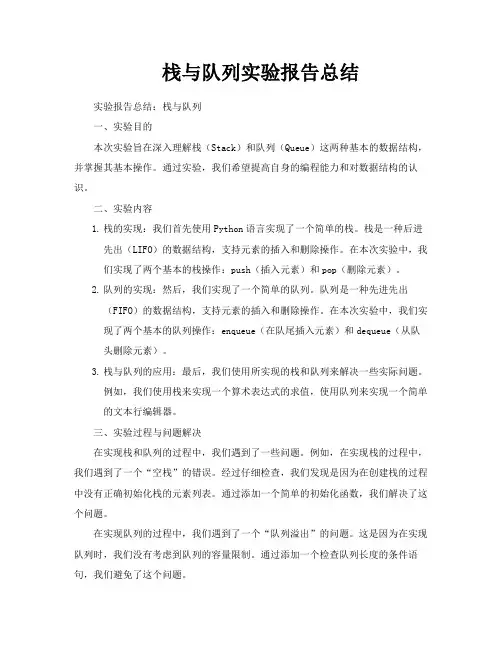
栈与队列实验报告总结实验报告总结:栈与队列一、实验目的本次实验旨在深入理解栈(Stack)和队列(Queue)这两种基本的数据结构,并掌握其基本操作。
通过实验,我们希望提高自身的编程能力和对数据结构的认识。
二、实验内容1.栈的实现:我们首先使用Python语言实现了一个简单的栈。
栈是一种后进先出(LIFO)的数据结构,支持元素的插入和删除操作。
在本次实验中,我们实现了两个基本的栈操作:push(插入元素)和pop(删除元素)。
2.队列的实现:然后,我们实现了一个简单的队列。
队列是一种先进先出(FIFO)的数据结构,支持元素的插入和删除操作。
在本次实验中,我们实现了两个基本的队列操作:enqueue(在队尾插入元素)和dequeue(从队头删除元素)。
3.栈与队列的应用:最后,我们使用所实现的栈和队列来解决一些实际问题。
例如,我们使用栈来实现一个算术表达式的求值,使用队列来实现一个简单的文本行编辑器。
三、实验过程与问题解决在实现栈和队列的过程中,我们遇到了一些问题。
例如,在实现栈的过程中,我们遇到了一个“空栈”的错误。
经过仔细检查,我们发现是因为在创建栈的过程中没有正确初始化栈的元素列表。
通过添加一个简单的初始化函数,我们解决了这个问题。
在实现队列的过程中,我们遇到了一个“队列溢出”的问题。
这是因为在实现队列时,我们没有考虑到队列的容量限制。
通过添加一个检查队列长度的条件语句,我们避免了这个问题。
四、实验总结与反思通过本次实验,我们对栈和队列这两种基本的数据结构有了更深入的理解。
我们掌握了如何使用Python语言实现这两种数据结构,并了解了它们的基本操作和实际应用。
在实现栈和队列的过程中,我们也学到了很多关于编程的技巧和方法。
例如,如何调试代码、如何设计数据结构、如何优化算法等。
这些技巧和方法将对我们今后的学习和工作产生积极的影响。
然而,在实验过程中我们也发现了一些不足之处。
例如,在实现栈和队列时,我们没有考虑到异常处理和性能优化等方面的问题。
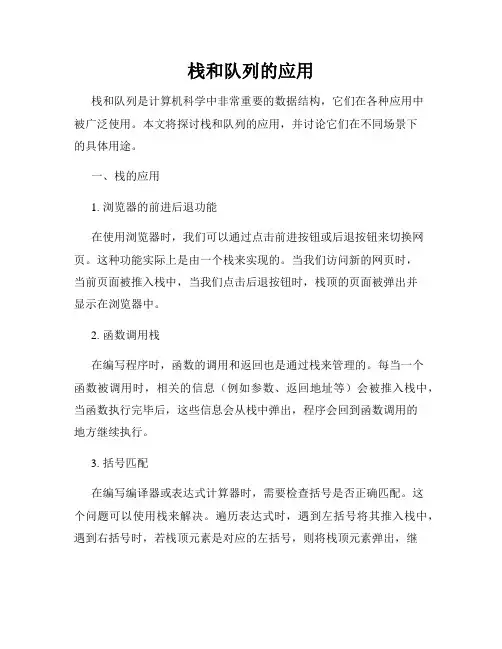
栈和队列的应用栈和队列是计算机科学中非常重要的数据结构,它们在各种应用中被广泛使用。
本文将探讨栈和队列的应用,并讨论它们在不同场景下的具体用途。
一、栈的应用1. 浏览器的前进后退功能在使用浏览器时,我们可以通过点击前进按钮或后退按钮来切换网页。
这种功能实际上是由一个栈来实现的。
当我们访问新的网页时,当前页面被推入栈中,当我们点击后退按钮时,栈顶的页面被弹出并显示在浏览器中。
2. 函数调用栈在编写程序时,函数的调用和返回也是通过栈来管理的。
每当一个函数被调用时,相关的信息(例如参数、返回地址等)会被推入栈中,当函数执行完毕后,这些信息会从栈中弹出,程序会回到函数调用的地方继续执行。
3. 括号匹配在编写编译器或表达式计算器时,需要检查括号是否正确匹配。
这个问题可以使用栈来解决。
遍历表达式时,遇到左括号将其推入栈中,遇到右括号时,若栈顶元素是对应的左括号,则将栈顶元素弹出,继续处理下一个字符;若栈为空或栈顶元素不是对应的左括号,则括号不匹配。
二、队列的应用1. 消息队列消息队列是一种在分布式系统中实现异步通信的机制。
它常用于解耦系统中的组件,例如,一个组件将消息发送到队列中,而另一个组件则从队列中接收消息并处理。
这种方式可以提高系统的可伸缩性和可靠性。
2. 打印队列在打印机系统中,多个任务需要按照先后顺序进行打印。
这时可以使用队列来管理打印任务的顺序。
每当一个任务到达时,将其加入到队列的末尾,打印机从队列的头部取出任务进行打印,直到队列为空。
3. 广度优先搜索广度优先搜索(BFS)是一种常用的图搜索算法,它使用队列来辅助实现。
在BFS中,首先将起始节点加入队列中,然后依次将与当前节点相邻且未访问过的节点入队,直到遍历完所有节点。
结论栈和队列作为常用的数据结构,在计算机科学中有着广泛的应用。
本文只介绍了它们部分的应用场景,实际上它们还可以用于解决其他许多问题,如迷宫路径搜索、计算器计算等。
因此,了解和熟练运用栈和队列是程序员和计算机科学家的基本素养之一。
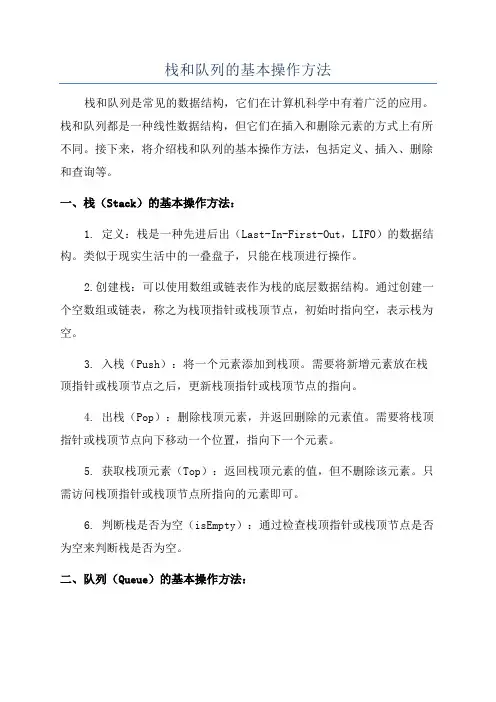
栈和队列的基本操作方法栈和队列是常见的数据结构,它们在计算机科学中有着广泛的应用。
栈和队列都是一种线性数据结构,但它们在插入和删除元素的方式上有所不同。
接下来,将介绍栈和队列的基本操作方法,包括定义、插入、删除和查询等。
一、栈(Stack)的基本操作方法:1. 定义:栈是一种先进后出(Last-In-First-Out,LIFO)的数据结构。
类似于现实生活中的一叠盘子,只能在栈顶进行操作。
2.创建栈:可以使用数组或链表作为栈的底层数据结构。
通过创建一个空数组或链表,称之为栈顶指针或栈顶节点,初始时指向空,表示栈为空。
3. 入栈(Push):将一个元素添加到栈顶。
需要将新增元素放在栈顶指针或栈顶节点之后,更新栈顶指针或栈顶节点的指向。
4. 出栈(Pop):删除栈顶元素,并返回删除的元素值。
需要将栈顶指针或栈顶节点向下移动一个位置,指向下一个元素。
5. 获取栈顶元素(Top):返回栈顶元素的值,但不删除该元素。
只需访问栈顶指针或栈顶节点所指向的元素即可。
6. 判断栈是否为空(isEmpty):通过检查栈顶指针或栈顶节点是否为空来判断栈是否为空。
二、队列(Queue)的基本操作方法:1. 定义:队列是一种先进先出(First-In-First-Out,FIFO)的数据结构。
类似于现实生活中的排队,按照先后顺序依次进入队列,先进入队列的元素首先被删除。
2.创建队列:可以使用数组或链表作为队列的底层数据结构。
通过创建一个空数组或链表,分别设置一个队首指针和一个队尾指针,初始时指向空,表示队列为空。
3. 入队(Enqueue):将一个元素添加到队尾。
需要将新增元素放在队尾指针或队尾节点之后,更新队尾指针或队尾节点的指向。
4. 出队(Dequeue):删除队首元素,并返回删除的元素值。
需要将队首指针或队首节点向下移动一个位置,指向下一个元素。
5. 获取队首元素(Front):返回队首元素的值,但不删除该元素。
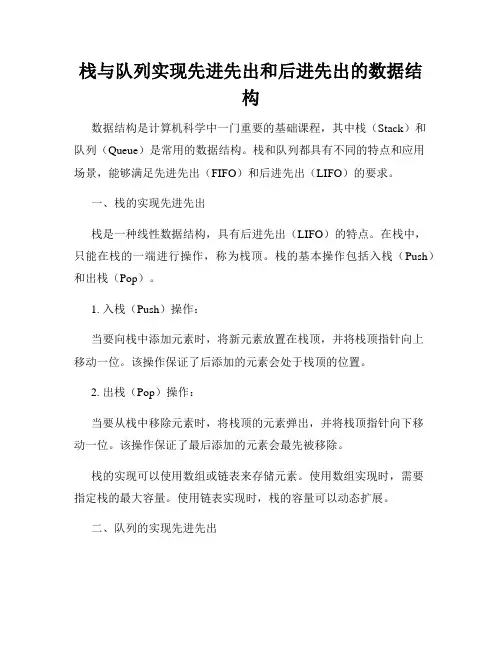
栈与队列实现先进先出和后进先出的数据结构数据结构是计算机科学中一门重要的基础课程,其中栈(Stack)和队列(Queue)是常用的数据结构。
栈和队列都具有不同的特点和应用场景,能够满足先进先出(FIFO)和后进先出(LIFO)的要求。
一、栈的实现先进先出栈是一种线性数据结构,具有后进先出(LIFO)的特点。
在栈中,只能在栈的一端进行操作,称为栈顶。
栈的基本操作包括入栈(Push)和出栈(Pop)。
1. 入栈(Push)操作:当要向栈中添加元素时,将新元素放置在栈顶,并将栈顶指针向上移动一位。
该操作保证了后添加的元素会处于栈顶的位置。
2. 出栈(Pop)操作:当要从栈中移除元素时,将栈顶的元素弹出,并将栈顶指针向下移动一位。
该操作保证了最后添加的元素会最先被移除。
栈的实现可以使用数组或链表来存储元素。
使用数组实现时,需要指定栈的最大容量。
使用链表实现时,栈的容量可以动态扩展。
二、队列的实现先进先出队列是一种线性数据结构,具有先进先出(FIFO)的特点。
在队列中,元素从队尾入队,从队头出队。
队列的基本操作包括入队(Enqueue)和出队(Dequeue)。
1. 入队(Enqueue)操作:当要向队列中添加元素时,将新元素放置在队尾,并将队尾指针向后移动一位。
该操作保证了后添加的元素会处于队列的尾部。
2. 出队(Dequeue)操作:当要从队列中移除元素时,将队头的元素弹出,并将队头指针向后移动一位。
该操作保证了最早添加的元素会最先被移除。
队列的实现也可以使用数组或链表。
与栈不同的是,队列的实现更适合使用链表,因为链表可以实现在队头和队尾高效地执行插入和删除操作。
三、使用栈和队列实现先进先出和后进先出为了实现先进先出和后进先出的数据结构,可以使用一种特殊的数据结构:双端队列(Double-ended Queue),也称为双端栈(Deque)。
双端队列具有栈和队列的特点,既可以在队尾插入和删除元素,也可以在队头插入和删除元素。
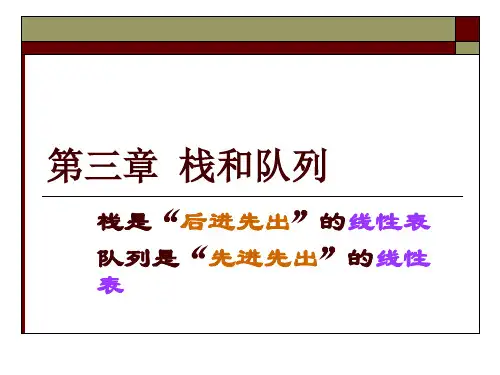
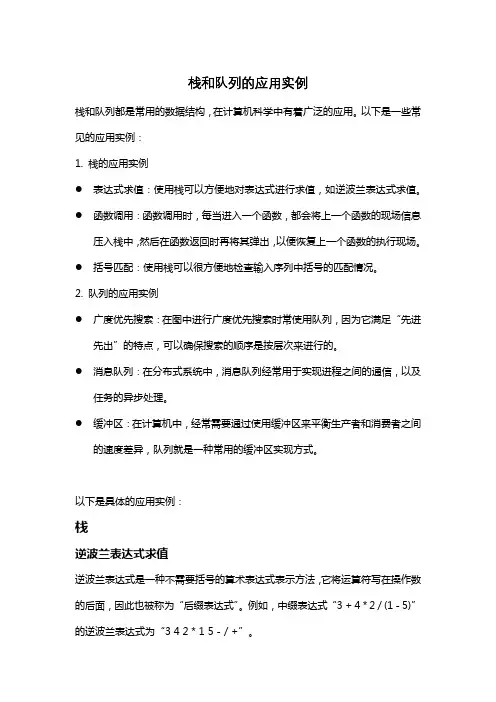
栈和队列的应用实例栈和队列都是常用的数据结构,在计算机科学中有着广泛的应用。
以下是一些常见的应用实例:1. 栈的应用实例●表达式求值:使用栈可以方便地对表达式进行求值,如逆波兰表达式求值。
●函数调用:函数调用时,每当进入一个函数,都会将上一个函数的现场信息压入栈中,然后在函数返回时再将其弹出,以便恢复上一个函数的执行现场。
●括号匹配:使用栈可以很方便地检查输入序列中括号的匹配情况。
2. 队列的应用实例●广度优先搜索:在图中进行广度优先搜索时常使用队列,因为它满足“先进先出”的特点,可以确保搜索的顺序是按层次来进行的。
●消息队列:在分布式系统中,消息队列经常用于实现进程之间的通信,以及任务的异步处理。
●缓冲区:在计算机中,经常需要通过使用缓冲区来平衡生产者和消费者之间的速度差异,队列就是一种常用的缓冲区实现方式。
以下是具体的应用实例:栈逆波兰表达式求值逆波兰表达式是一种不需要括号的算术表达式表示方法,它将运算符写在操作数的后面,因此也被称为“后缀表达式”。
例如,中缀表达式“3 + 4 * 2 / (1 - 5)”的逆波兰表达式为“3 4 2 * 1 5 - / +”。
逆波兰表达式求值时,可以使用栈来存储数字和运算符,具体过程如下:1. 遍历逆波兰表达式中的每个元素。
2. 如果当前元素是数字,则压入栈中。
3. 如果当前元素是运算符,则从栈中弹出两个操作数进行运算,并将结果压入栈中。
4. 遍历完逆波兰表达式后,栈顶即为表达式的值。
以下是Python语言实现逆波兰表达式求值的代码:def evalRPN(tokens: List[str]) -> int:stack = []for token in tokens:if token in '+-*/': # 运算符num2 = stack.pop()num1 = stack.pop()if token == '+':stack.append(num1 + num2)elif token == '-':stack.append(num1 - num2)elif token == '*':stack.append(num1 * num2)else:stack.append(int(num1 / num2))else: # 数字stack.append(int(token))return stack[0]该函数接受一个字符串列表tokens,其中包含了逆波兰表达式的所有元素。
栈和队列的应用实验报告栈和队列的应用实验报告引言:栈和队列是计算机科学中常用的数据结构,它们在各种算法和应用中都有广泛的应用。
本实验报告旨在探讨栈和队列的基本概念、特性以及它们在实际应用中的具体使用。
一、栈的基本概念和特性栈是一种特殊的数据结构,它遵循“先进后出”的原则。
栈有两个基本操作:压栈(push)和弹栈(pop)。
压栈将元素添加到栈的顶部,弹栈则将栈顶元素移除。
栈还具有一个重要的特性,即它的访问方式是受限的,只能访问栈顶元素。
在实际应用中,栈可以用于实现递归算法、表达式求值、括号匹配等。
例如,在递归算法中,当函数调用自身时,需要将当前状态保存到栈中,以便在递归结束后能够恢复到正确的状态。
另外,栈还可以用于实现浏览器的“后退”功能,每次浏览新页面时,将当前页面的URL压入栈中,当用户点击“后退”按钮时,再从栈中弹出最近访问的URL。
二、队列的基本概念和特性队列是另一种常见的数据结构,它遵循“先进先出”的原则。
队列有两个基本操作:入队(enqueue)和出队(dequeue)。
入队将元素添加到队列的尾部,出队则将队列头部的元素移除。
与栈不同的是,队列可以访问头部和尾部的元素。
在实际应用中,队列经常用于任务调度、消息传递等场景。
例如,在操作系统中,任务调度器使用队列来管理待执行的任务,每当一个任务执行完毕后,从队列中取出下一个任务进行执行。
另外,消息队列也是一种常见的应用,它用于在分布式系统中传递消息,保证消息的顺序性和可靠性。
三、栈和队列在实际应用中的具体使用1. 栈的应用栈在计算机科学中有广泛的应用。
其中一个典型的应用是表达式求值。
当计算机遇到一个复杂的表达式时,需要将其转化为逆波兰表达式,然后使用栈来进行求值。
栈的特性使得它非常适合处理这种情况,可以方便地保存运算符和操作数的顺序,并按照正确的顺序进行计算。
另一个常见的应用是括号匹配。
在编程语言中,括号是一种常见的语法结构,需要保证括号的匹配性。
栈和队列基本操作实验报告实验二堆栈和队列基本操作的编程实现【实验目的】堆栈和队列基本操作的编程实现要求:堆栈和队列基本操作的编程实现(2学时,验证型),掌握堆栈和队列的建立、进栈、出栈、进队、出队等基本操作的编程实现,存储结构可以在顺序结构或链接结构中任选,也可以全部实现。
也鼓励学生利用基本操作进行一些应用的程序设计。
【实验性质】验证性实验(学时数:2H)【实验内容】内容:把堆栈和队列的顺序存储(环队)和链表存储的数据进队、出队等运算其中一部分进行程序实现。
可以实验一的结果自己实现数据输入、数据显示的函数。
利用基本功能实现各类应用,如括号匹配、回文判断、事物排队模拟、数据逆序生成、多进制转换等。
【实验分析、说明过程】分析:进栈操作先创建一个以x为值的新结点p,其data域值为x则进栈操作步骤如下: 将新结点p的指针域指向原栈顶S(执行语句p->next=S)。
将栈顶S指向新结点p(执行语句S=p)。
注:进栈操作的?与?语句执行顺序不能颠倒,否则原S指针其后的链表将丢失。
出栈操作先将结点栈顶S数据域中的值赋给指针变量*x,则删除操作步骤如下: 结点p 指针域指向原栈顶S(执行语句p=S)。
栈顶S指向其的下一个结点(执行语句S=S->next)释放p结点空间(执行语句free(p))。
队列分析:用链式存储结构实现的队列称为链队列,一个链队列需要一个队头指针和一个队尾指针才能唯一确定。
队列中元素的结构和前面单链表中的结点的结构一样。
为了操作方便,在队头元素前附加一个头结点,队头指针就指向头结点。
【思考问题】1. 栈的顺序存储和链表存储的差异,答:栈的顺序存储有‘后进先出’的特点,最后进栈的元素必须最先出来,进出栈是有序的,在对编某些需要按顺序操作的程序有很大的作用。
链表存储:通过链表的存储可以实现链表中任意位置的插入元素,删除任意元素,可以实现无序进出。
2. 还会有数据移动吗,为什么,答:栈的顺序存储不会有数据移动,移动的只是指向该数据地址的指针。
栈和队列的应用场景栈和队列是数据结构中常见的两种基本数据结构,它们在实际生活和计算机领域中有着广泛的应用场景。
本文将从实际应用的角度出发,介绍栈和队列在不同场景下的具体应用。
### 一、栈的应用场景#### 1.1 浏览器的后退和前进功能在浏览器中,当我们访问一个网页时,浏览器会将该网页的 URL 存储在一个栈中。
当我们点击后退按钮时,浏览器会从栈顶取出上一个网页的 URL,实现后退功能;当我们点击前进按钮时,浏览器会从栈中取出下一个网页的 URL,实现前进功能。
#### 1.2 括号匹配在编程中,栈常用于检查表达式中的括号是否匹配。
当遇到左括号时,将其入栈;当遇到右括号时,将栈顶元素出栈并与右括号进行匹配。
如果匹配成功,则继续;如果匹配失败,则表达式中存在不匹配的括号。
#### 1.3 撤销操作在文本编辑器或图像处理软件中,撤销操作通常使用栈来实现。
每次编辑操作都会将编辑内容存储在栈中,当用户点击撤销按钮时,软件会从栈中取出上一个编辑操作,实现撤销功能。
### 二、队列的应用场景#### 2.1 系统任务调度在操作系统中,队列常用于实现任务调度。
操作系统会将需要执行的任务按照先来先服务的原则排入队列,然后逐个执行。
这种方式可以保证任务的顺序性和公平性。
#### 2.2 打印队列在打印机中,打印任务通常按照先后顺序排入打印队列中,然后依次执行。
这样可以避免多个打印任务同时请求打印,导致打印机发生冲突。
#### 2.3 消息队列在分布式系统中,消息队列被广泛应用于解耦和异步处理。
生产者将消息发送到队列中,消费者从队列中取出消息并进行处理,实现了生产者和消费者之间的解耦。
### 三、栈和队列的综合应用场景#### 3.1 模拟计算器在计算器的设计中,可以使用栈来实现表达式的计算。
将中缀表达式转换为后缀表达式,然后利用栈来计算后缀表达式的值,实现计算器的功能。
#### 3.2 资源分配在操作系统中,可以使用队列来实现资源的分配。
一、实验目的1. 理解栈和队列的基本概念、特点及逻辑结构。
2. 掌握栈和队列的存储结构,包括顺序存储结构和链式存储结构。
3. 熟练掌握栈和队列的基本操作,如入栈、出栈、入队、出队等。
4. 分析栈和队列在实际问题中的应用,提高解决实际问题的能力。
二、实验内容1. 栈和队列的定义及特点2. 栈和队列的存储结构3. 栈和队列的基本操作4. 栈和队列的实际应用案例分析三、实验过程1. 栈和队列的定义及特点栈(Stack)是一种后进先出(Last In First Out,LIFO)的数据结构,它只允许在一端进行插入和删除操作。
栈的典型应用场景有函数调用、递归算法等。
队列(Queue)是一种先进先出(First In First Out,FIFO)的数据结构,它允许在两端进行插入和删除操作。
队列的典型应用场景有打印队列、任务队列等。
2. 栈和队列的存储结构(1)顺序存储结构栈和队列的顺序存储结构使用数组来实现。
对于栈,通常使用数组的一端作为栈顶,入栈操作在栈顶进行,出栈操作也在栈顶进行。
对于队列,通常使用数组的一端作为队首,入队操作在队尾进行,出队操作在队首进行。
(2)链式存储结构栈和队列的链式存储结构使用链表来实现。
对于栈,每个元素节点包含数据和指向下一个节点的指针。
入栈操作在链表头部进行,出栈操作在链表头部进行。
对于队列,每个元素节点包含数据和指向下一个节点的指针。
入队操作在链表尾部进行,出队操作在链表头部进行。
3. 栈和队列的基本操作(1)栈的基本操作- 入栈(push):将元素添加到栈顶。
- 出栈(pop):从栈顶删除元素。
- 获取栈顶元素(peek):获取栈顶元素,但不删除它。
- 判断栈空(isEmpty):判断栈是否为空。
(2)队列的基本操作- 入队(enqueue):将元素添加到队列尾部。
- 出队(dequeue):从队列头部删除元素。
- 获取队首元素(peek):获取队首元素,但不删除它。
栈和队列的应用实验报告
《栈和队列的应用实验报告》
一、实验目的
本实验旨在通过实际操作,掌握栈和队列的基本概念、操作及应用,加深对数
据结构的理解和应用能力。
二、实验内容
1. 栈的基本操作:包括入栈、出栈、获取栈顶元素等。
2. 队列的基本操作:包括入队、出队、获取队首元素等。
3. 栈和队列的应用:通过实际案例,探讨栈和队列在实际生活中的应用场景。
三、实验步骤
1. 学习栈和队列的基本概念和操作。
2. 编写栈和队列的基本操作代码,并进行调试验证。
3. 分析并实现栈和队列在实际应用中的案例,如表达式求值、迷宫问题等。
4. 进行实际应用案例的测试和验证。
四、实验结果
1. 成功实现了栈和队列的基本操作,并通过实际案例验证了其正确性和可靠性。
2. 通过栈和队列在实际应用中的案例,加深了对数据结构的理解和应用能力。
五、实验总结
通过本次实验,我深刻理解了栈和队列的基本概念和操作,并掌握了它们在实
际应用中的重要性和作用。
栈和队列作为数据结构中的重要内容,对于解决实
际问题具有重要意义,希望通过不断的实践和学习,能够更加熟练地运用栈和
队列解决实际问题,提高自己的编程能力和应用能力。
六、感想与展望
本次实验让我对栈和队列有了更深入的了解,也让我对数据结构有了更加深刻的认识。
我将继续学习和探索更多的数据结构知识,提高自己的编程能力和解决问题的能力,为将来的学习和工作打下坚实的基础。
同时,我也希望能够将所学知识应用到实际工程中,为社会做出更大的贡献。
栈和队列区别及应用场景栈(Stack)和队列(Queue)是两种常见的数据结构,它们在计算机科学领域有广泛的应用。
本文将从定义、特点和基本操作等方面详细介绍栈和队列的区别,并分析它们各自的应用场景。
一、栈的定义及特点:栈是一种线性数据结构,其特点是“先进后出”(Last In First Out,LIFO)。
即在栈中最后一个进入的元素,也是第一个出栈的元素。
栈的基本操作包括入栈和出栈。
入栈(Push)是将一个元素追加到栈的顶部,出栈(Pop)是将栈顶元素移除。
栈的应用场景:1.函数调用:在函数调用时,每遇到一个新的函数调用就将当前的上下文(包括局部变量和返回地址)压入栈中,当函数调用完毕后,再弹出栈顶元素,恢复上一个函数的上下文。
2.表达式求值:栈可以用于进行中缀表达式到后缀表达式的转换,并通过栈来计算后缀表达式的值。
3.递归:递归算法的实现中通常会使用栈来保存递归调用的上下文。
4.撤销操作:在很多应用程序中,比如文本编辑器和图像处理软件中,通过栈来存储用户操作,以便可以撤销之前的操作。
5.浏览器历史记录:浏览器通常使用栈来实现历史记录的功能,每当用户浏览一个新的页面时,就将该页面的URL入栈,当用户点击后退按钮时,再依次出栈。
6.二叉树的遍历:用栈可以实现二叉树的深度优先遍历,具体的实现是使用非递归的方式进行前序、中序、后序遍历。
二、队列的定义及特点:队列也是一种线性数据结构,其特点是“先进先出”(First In First Out,FIFO)。
即在队列中最先进入的元素,也是第一个出队列的元素。
队列的基本操作包括入队和出队。
入队(Enqueue)是将元素放入队列的尾部,出队(Dequeue)是将队列的头部元素移除。
队列的应用场景:1.广度优先搜索:在图论中,广度优先搜索(Breadth First Search,BFS)通常会使用队列来实现,按照层次的顺序进行搜索。
2.缓冲区:队列可以用作缓冲区,在生产者和消费者模型中,生产者将数据放入队列的尾部,消费者从队列的头部取出数据进行处理。
实验二栈和队列的基本操作实现及其应用一、实验目的1、熟练掌握栈和队列的基本操作在两种存储结构上的实现。
2、会用栈和队列解决简单的实际问题。
二、实验内容(可任选或全做)题目一、试写一个算法,判断依次读入的一个以@为结束符的字符序列,是否为回文。
所谓“回文“是指正向读和反向读都一样的一字符串,如“321123”或“ableelba”。
相关常量及结构定义:# define STACK_INIT_SIZE 100# define STACKINCREMENT 10# define OK 1# define ERROR 0typedef int SElemType;//栈类型定义typedef struct SqStack{ SElemType *base;SElemType *top;int stacksize;}SqStack;设计相关函数声明:判断函数:int IsReverse()栈:int InitStack(SqStack &S )int Push(SqStack &S, SElemType e )int Pop(SqStack &S,SElemType &e)int StackEmpty(s)题目二、编程模拟队列的管理,主要包括:出队列、入队、统计队列的长度、查找队列某个元素e、及输出队列中元素。
[实现提示]:参考教材循环队列的有关算法,其中后两个算法参考顺序表的实现。
题目三、RailsDescriptionThere is a famous railway station in PopPush City. Country there is incredibly hilly. The station was built in last century. Unfortunately, funds were extremely limited that time. It was possible to establish only a surface track. Moreover, it turned out that the station could be only a dead-end one (see picture) and due to lack of available space it could have only one track.The local tradition is that every train arriving from the direction A continues in the direction B with coaches reorganized in some way. Assume that the train arriving from the direction A has N <= 1000 coaches numbered in increasing order 1, 2, ..., N. The chief for train reorganizations must know whether it is possible to marshal coaches continuing in the direction B so that their order will be a1, a2, ..., aN. Help him and write a program that decides whether it is possible to get the required order of coaches. You can assume that single coaches can be disconnected from the train before they enter the station and that they can move themselves until they are on the track in the direction B. You can also suppose that at any time there can be located as many coaches as necessary in the station. But once a coach has entered the station it cannot return to the track in the direction A and also once it has left the station in the direction B it cannot return back to the station.InputThe input consists of blocks of lines. Each block except the last describes one train and possibly more requirements for its reorganization. In the first line of the block there is the integer N described above. In each of the next lines of the block there is a permutation of 1, 2, ..., N. The last line of the block contains just 0.The last block consists of just one line containing 0.OutputThe output contains the lines corresponding to the lines with permutations in the input.A line of the output contains Yes if it is possible to marshal the coaches in the order required on the corresponding line of the input. Otherwise it contains No. In addition, there is one empty line after the lines corresponding to one block of the input. There is no line in the output corresponding to the last ``null'' block of the input.Sample Input51 2 3 4 55 4 1 2 366 5 4 3 2 1Sample OutputYesNoYes题目四、Sliding WindowDescriptionAn array of size n≤ 106 is given to you. There is a sliding window of size k which is moving from the very left of the array to the very right. You can only see the k numbers in the window. Each time the sliding window moves rightwards by one position. Following is an example:The array is [1 3 -1 -3 5 3 6 7], and k is 3.Window position Minimum value Maximum value[1 3 -1] -3 5 3 6 7 -131 [3 -1 -3] 5 3 6 7 -331 3 [-1 -3 5] 3 6 7 -351 3 -1 [-3 5 3] 6 7 -351 3 -1 -3 [5 3 6] 7 361 3 -1 -3 5 [3 6 7]37Your task is to determine the maximum and minimum values in the sliding window at each position.InputThe input consists of two lines. The first line contains two integers n and k which are the lengths of the array and the sliding window. There are n integers in the second line.OutputThere are two lines in the output. The first line gives the minimum values in the window at each position, from left to right, respectively. The second line gives the maximum values.Sample Input8 31 3 -1 -3 5 3 6 7Sample Output-1 -3 -3 -3 3 33 3 5 5 6 7题目五(选作考查串知识)DNA Evolution【Description】Evolution is a seemingly random process which works in a way which resembles certain approaches we use to get approximate solutions to hard combinatorial problems. You are now to do something completely different.Given a DNA string S from the alphabet {A,C,G,T}, find the minimal number of copy operations needed to create another string T. You may reverse the strings you copy, and copy both from S and the pieces of your partial T. You may put these piecestogether at any time. You may only copy contiguous parts of your partial T, and all copied strings must be used in your final T.Example: From S= “ACTG” create T= “GTACTAATAAT”1.Get GT......... by copying and reversing "TG" from S.2.Get GT AC... by copying "AC" from S.3.Get GTAC T A….. by copying "TA" from the partial T.4.Get GTACTA AT by copying and reversing "TA" from the partial T.5.Get GTACTAA T AAT by copying "AA T" from the partial T.【Input】The first line of input gives a single integer, 1 ≤k≤10, the number of test cases. Then follow, for each test case, a line with the string S , length of S is less then 19, and a line with the string T , length of T is less then 19.【Output】Output for each test case the number of copy operations needed to create T from S, or "impossible" if it cannot be done.【Sample Input】4ACGTTGCAACACGTTCGATCGAAAAAAAAAAAAAAAAAAAA【Sample output】1impossible46题目六(选作考查数组知识)Magic Squares描述Following the success of the magic cube, Mr. Rubik invented its planar version, called magic squares. This is a sheet composed of 8 equal-sized squares:1 2 3 48 7 6 5In this task we consider the version where each square has a different color. Colors are denoted by the first 8 positive integers. A sheet configuration is given by the sequence of colors obtained by reading the colors of the squares starting at the upper left corner and going in clockwise direction. For instance, the configuration of Figure 3 is given by the sequence (1,2,3,4,5,6,7,8). This configuration is the initial configuration.Three basic transformations, identified by the letters `A', `B' and `C', can be applied to a sheet:∙'A': exchange the top and bottom row,∙'B': single right circular shifting of the rectangle,∙'C': single clockwise rotation of the middle four squares.Below is a demonstration of applying the transformations to the initial squares given above:A:8 7 6 51 2 3 4B:4 1 2 35 8 7 6C:1 72 48 6 3 5All possible configurations are available using the three basic transformations.You are to write a program that computes a minimal sequence of basic transformations that transforms the initial configuration above to a specific target configuration.输入A single line with eight space-separated integers (a permutation of (1..8)) that are the target configuration.输出Line 1: A single integer that is the length of the shortest transformation sequence.Line 2: The lexically earliest string of transformations expressed as a string of characters, 60 per line except possibly the last line.样例输入2 6 8 4 5 73 1样例输出7BCABCCB三、实验步骤㈠、数据结构与核心算法的设计描述㈡、函数调用及主函数设计(可用函数的调用关系图说明)㈢程序调试及运行结果分析㈣实验总结四、主要算法流程图及程序清单1、主要算法流程图:2、程序清单(程序过长,可附主要部分)//int IsReverse(){ ….while( (e=getchar())!='@'){e 依次入栈、入队 //push(S,e);EnQueue(Q,e);……..}While(!StackEmpty(S)){ pop(S,a);DeQueue(Q,b);If(a!=b) return 0;}return 1;}。